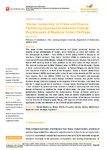’Global Modernity’ in China and France: Flattening boundaries between Foreign Brandscapes & Regional Urban Heritage
| dc.contributor.author | Troiani, I | en |
| dc.date.accessioned | 2020-09-06T15:20:17Z | |
| dc.date.issued | 2019 | en |
| dc.identifier.uri | http://hdl.handle.net/10026.1/16227 | |
| dc.description.abstract |
This paper studies transnational architecture and ‘global modernity’ through the reading of two photographs of foreign, iconic buildings in China and France. The first photograph by Hufton + Crow (2012) is of the Galaxy SOHO in Beijing by the Iraqi-born, British architect, Zaha Hadid Architect (ZHA) in collaboration with the state-ownedChineseBIAD(BeijingInstituteofArchitectureandDesign).Thelandmark, futurist ZHA building looks to have gobbled up the local urban heritage around it. The second photograph by Marc Petitjean taken in 1975 is of the Pompidou Centre in Paris under-construction and was designed by Richard Rogers and Renzo Piano with Gianfranco Franchini. In front of the Pompidou Centre is Gordon Matta-Clark’s Conical Intersect (1975) contained within a row of soon-to-be-demolished 17th century townhouses. Both the Galaxy SOHO and the Centre Pompidou are examples of transnational architecture where foreign architects crossing new global market frontiers, design landmark buildings at the expense of local heritage. They show how the rise in image culture tied to capitalism–through global branding and brand scapes – and promoted by ‘governmentality’ nurtures a culture of producing and consuming foreign architecture to redefine the image of nation state. The paper discusses how globalisation ‘flattens’ regionalism for modernisation. Foreign architects working on transnational architecture and their clients have an ethical responsibility to resist ‘cultural [architectural] imperialism’ (including the visual allure of the West as the alpha culture) and should instead engage deeply with regional and domestic urban values, typologies, scales and traditions to be critical of global capitalism. | |
| dc.language.iso | en | en |
| dc.title | ’Global Modernity’ in China and France: Flattening boundaries between Foreign Brandscapes & Regional Urban Heritage | en |
| dc.type | Conference Contribution | |
| plymouth.conference-name | Architecture Across Boundaries | en |
| plymouth.journal | Architecture Across Boundaries Conference Proceedings | en |
| dc.identifier.doi | 10.18502/kss.v3i27.5513 | en |
| plymouth.organisational-group | /Plymouth | |
| plymouth.organisational-group | /Plymouth/Faculty of Arts, Humanities and Business | |
| plymouth.organisational-group | /Plymouth/REF 2021 Researchers by UoA | |
| plymouth.organisational-group | /Plymouth/REF 2021 Researchers by UoA/UoA13 Architecture, Built Environment and Planning | |
| plymouth.organisational-group | /Plymouth/REF 2021 Researchers by UoA/UoA13 Architecture, Built Environment and Planning/UoA13 Architecture, Built Environment and Planning MANUAL | |
| plymouth.organisational-group | /Plymouth/Users by role | |
| plymouth.organisational-group | /Plymouth/Users by role/Academics | |
| dcterms.dateAccepted | 2018-05-01 | en |
| dc.rights.embargodate | 2020-09-08 | en |
| dc.rights.embargoperiod | Not known | en |
| rioxxterms.versionofrecord | 10.18502/kss.v3i27.5513 | en |
| rioxxterms.licenseref.uri | http://www.rioxx.net/licenses/all-rights-reserved | en |
| rioxxterms.licenseref.startdate | 2019 | en |
| rioxxterms.type | Conference Paper/Proceeding/Abstract | en |


